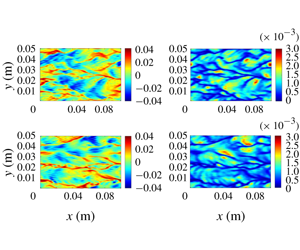Article contents
Large-eddy simulation of small-scale Langmuir circulation and scalar transport
Published online by Cambridge University Press: 18 December 2019
Abstract

Large-eddy simulation (LES) of a wind- and wave-forced water column based on the Craik–Leibovich (C–L) vortex force is used to understand the structure of small-scale Langmuir circulation (LC) and associated Langmuir turbulence. The LES also serves to understand the role of the turbulence in determining molecular diffusive scalar flux from a scalar-saturated air side to the water side and the turbulent vertical scalar flux in the water side. Previous laboratory experiments have revealed that small-scale LC beneath an initially quiescent air–water interface appears shortly after the initiation of wind-driven gravity–capillary waves and provides the laminar–turbulent transition in wind speeds between 3 and  $6~\text{m}~\text{s}^{-1}$. The LES reveals Langmuir turbulence characterized by multiple scales ranging from small bursting eddies at the surface that coalesce to give rise to larger (centimetre-scale) LC over time. It is observed that the smaller scales account for the bulk of the near-surface turbulent vertical scalar flux. Although the contribution of the larger (centimetre-scale) LC to the near-surface turbulent flux increases over time as these scales emerge and become more coherent, the contribution of the smaller scales remains dominant. The growing LC scales lead to increased vertical scalar transport at depths below the interface and thus greater scalar transfer efficiency. Simulations were performed with a fixed wind stress corresponding to a
$6~\text{m}~\text{s}^{-1}$. The LES reveals Langmuir turbulence characterized by multiple scales ranging from small bursting eddies at the surface that coalesce to give rise to larger (centimetre-scale) LC over time. It is observed that the smaller scales account for the bulk of the near-surface turbulent vertical scalar flux. Although the contribution of the larger (centimetre-scale) LC to the near-surface turbulent flux increases over time as these scales emerge and become more coherent, the contribution of the smaller scales remains dominant. The growing LC scales lead to increased vertical scalar transport at depths below the interface and thus greater scalar transfer efficiency. Simulations were performed with a fixed wind stress corresponding to a  $5~\text{m}~\text{s}^{-1}$ wind speed but with different wave parameters (wavelength and amplitude) in the C–L vortex force. It is observed that longer wavelengths lead to more coherent, larger centimetre-scale LC providing greater contribution to the turbulent vertical scalar flux away from the surface. In all cases, the molecular diffusive scalar flux at the water surface relaxes to the same statistically steady value after transition to Langmuir turbulence occurs, despite the different wave parameters in the C–L vortex force across the simulations. This implies that the small-scale turbulence intensity and the molecular diffusive scalar flux at the surface scale with the wind shear and not with the wave parameters. Furthermore, it is seen that the Langmuir (wave) forcing (provided by the C–L vortex force) is necessary to trigger the turbulence that induces elevated molecular diffusive scalar flux at the water surface relative to wind-driven flow without wave forcing.
$5~\text{m}~\text{s}^{-1}$ wind speed but with different wave parameters (wavelength and amplitude) in the C–L vortex force. It is observed that longer wavelengths lead to more coherent, larger centimetre-scale LC providing greater contribution to the turbulent vertical scalar flux away from the surface. In all cases, the molecular diffusive scalar flux at the water surface relaxes to the same statistically steady value after transition to Langmuir turbulence occurs, despite the different wave parameters in the C–L vortex force across the simulations. This implies that the small-scale turbulence intensity and the molecular diffusive scalar flux at the surface scale with the wind shear and not with the wave parameters. Furthermore, it is seen that the Langmuir (wave) forcing (provided by the C–L vortex force) is necessary to trigger the turbulence that induces elevated molecular diffusive scalar flux at the water surface relative to wind-driven flow without wave forcing.
- Type
- JFM Papers
- Information
- Copyright
- © 2019 Cambridge University Press
References
- 10
- Cited by


